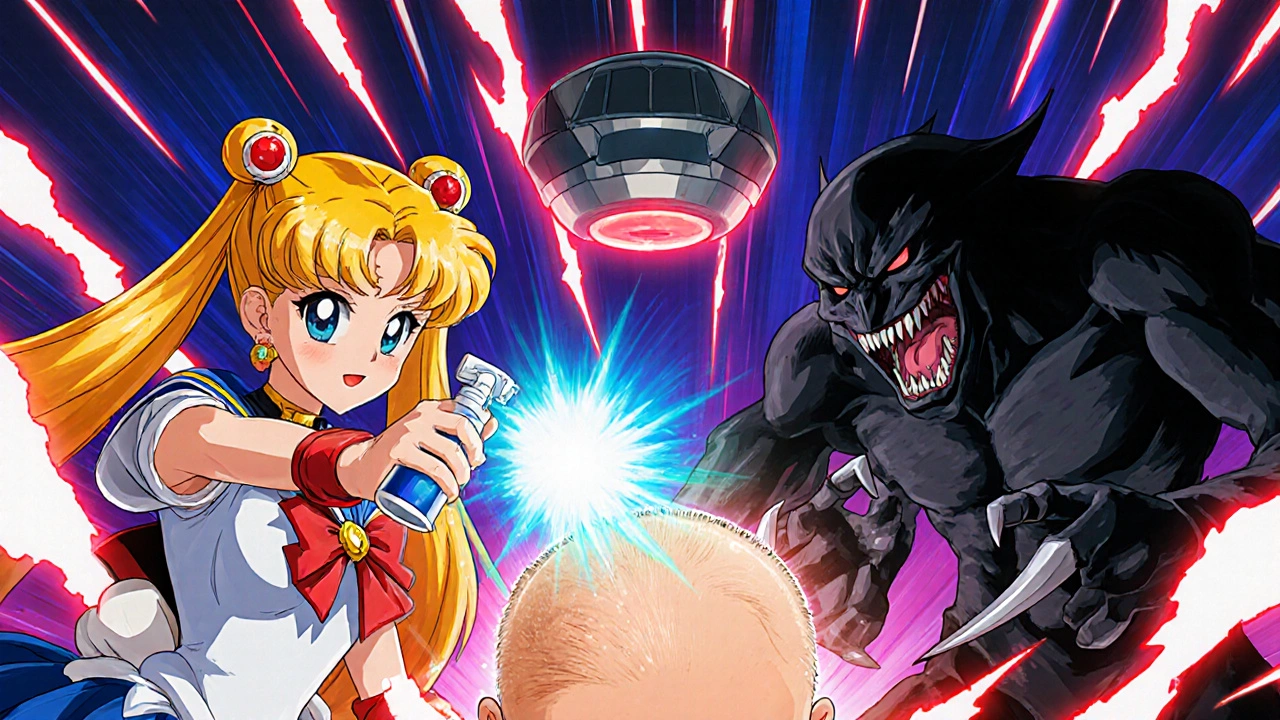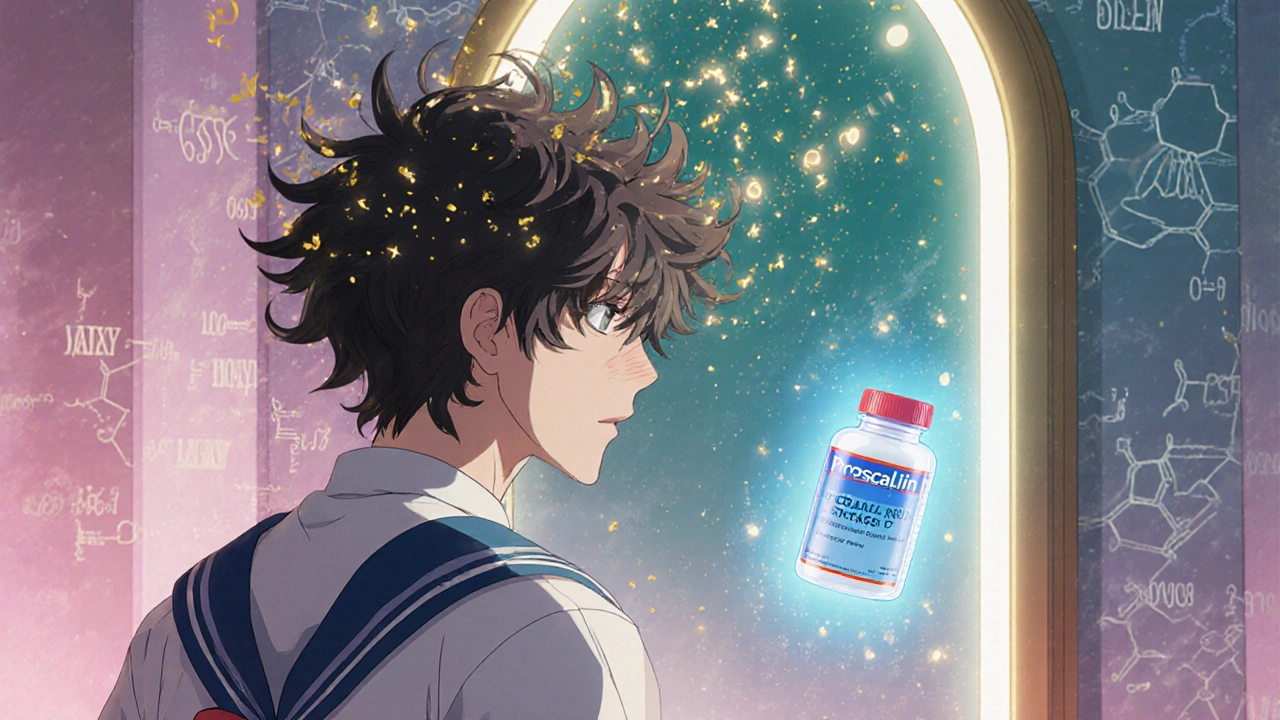Hair Loss Treatment Selector
Which treatment is right for you?
Answer these questions to get personalized recommendations based on clinical evidence from the article.
Finasteride is one of the most studied and prescribed drugs for male pattern hair loss. Sold under the brand name Proscalpin in the UK, it’s been helping men keep their hair for over 25 years. But it’s not the only option. Many people wonder: are there better, safer, or cheaper alternatives? And if you’re not seeing results-or dealing with side effects-what else can you try?
How Proscalpin (Finasteride) Actually Works
Proscalpin contains finasteride, a 5-alpha-reductase inhibitor. That’s a fancy way of saying it blocks the enzyme that turns testosterone into dihydrotestosterone (DHT). DHT is the hormone that shrinks hair follicles in people genetically prone to balding. Lower DHT = less follicle damage = slower hair loss, and sometimes regrowth.
Studies show that about 83% of men taking 1mg of finasteride daily stopped losing hair after two years. Around 66% saw noticeable regrowth. But it takes time: most people don’t see results until 3-6 months, and full effects can take up to a year. If you stop taking it, DHT levels rise again, and hair loss resumes within 6-12 months.
Common Side Effects of Proscalpin
Not everyone tolerates finasteride well. Around 1-2% of users report sexual side effects like reduced libido, erectile dysfunction, or decreased semen volume. These usually go away after stopping the drug, but in rare cases, they persist-something called Post-Finasteride Syndrome. It’s uncommon, but real. Other side effects include breast tenderness, skin rashes, and depression in a small subset of users.
Because of this, many men look for alternatives-either to avoid side effects, reduce cost, or because finasteride just isn’t working for them.
Alternative #1: Minoxidil (Rogaine)
Minoxidil is the only other FDA-approved treatment for hair loss that’s widely available over the counter. Unlike finasteride, it doesn’t touch hormones. Instead, it widens blood vessels around hair follicles, boosting blood flow and nutrient delivery. Think of it as a fertilizer for your scalp.
It comes as a liquid or foam, applied twice daily. Results are slower than finasteride-usually 4-6 months before you see anything. About 40% of men see moderate regrowth after a year. It doesn’t stop hair loss as effectively as finasteride, but it can add density where hair is thinning.
Pros: No sexual side effects. Works well when combined with finasteride. Available without a prescription.
Cons: Must be used forever. Can cause scalp irritation, itching, or unwanted facial hair growth. Messy application.
Many men use both finasteride and minoxidil together. Studies show this combo works better than either alone-up to 94% of men saw improved results after 12 months.
Alternative #2: Dutasteride (Avodart)
Dutasteride is similar to finasteride but stronger. It blocks both types of 5-alpha-reductase enzymes (Type I and II), while finasteride only blocks Type II. That means it lowers DHT by up to 90%-compared to finasteride’s 70%.
Some doctors prescribe it off-label for hair loss, especially for men who don’t respond to finasteride. A 2021 study in the Journal of the American Academy of Dermatology found dutasteride led to significantly greater hair growth after 12 months compared to finasteride.
Pros: More potent. Works faster for some. May help men who’ve stopped responding to finasteride.
Cons: Higher risk of side effects. Not officially approved for hair loss in the UK or US. Often more expensive. Requires a prescription.
If you’re considering dutasteride, talk to a dermatologist or trichologist. It’s not a first-line option, but it’s a valid backup.

Alternative #3: Natural Supplements (Saw Palmetto, Pumpkin Seed Oil, Biotin)
There’s a booming market for “natural” hair loss solutions. Saw palmetto, pumpkin seed oil, and biotin are the most popular. But here’s the truth: none of them have strong clinical proof.
Saw palmetto is often marketed as a “natural finasteride.” It does slightly inhibit 5-alpha-reductase, but studies show it reduces DHT by only 10-30%-far less than finasteride. One small 2012 trial found saw palmetto improved hair count in 60% of men, but the study lasted only 6 months and had no control group.
Pumpkin seed oil showed promise in a 2014 Korean study: men taking 400mg daily for 24 weeks saw a 40% increase in hair count. But again-small sample, no long-term data.
Biotin? It helps with brittle nails and hair only if you’re deficient. Most people aren’t. Taking extra biotin won’t regrow hair if your follicles are dying from DHT.
These supplements are safe, but don’t expect miracles. They’re best as add-ons-not replacements-for proven treatments.
Alternative #4: Low-Level Laser Therapy (LLLT)
Devices like laser combs, caps, and helmets use red light to stimulate hair follicles. The theory: light energy boosts cellular activity in the scalp, encouraging hair growth.
The FDA cleared some devices in the 2000s. A 2019 meta-analysis in Lasers in Surgery and Medicine found LLLT improved hair density in 55-70% of users after 16-26 weeks. Results are modest-less than finasteride-but non-invasive and side-effect free.
Pros: No pills, no hormones. Safe for long-term use. Can be used with other treatments.
Cons: Expensive (£200-£600 for devices). Requires 3-5 sessions per week. Takes months to see results. Not covered by the NHS.
Good for men who want a drug-free option or are using finasteride but want to boost results.
Alternative #5: Hair Transplants
If you’ve lost a lot of hair and other treatments haven’t worked, a transplant might be the only real solution. It involves moving healthy hair follicles from the back of your head to thinning areas.
Modern techniques like FUE (Follicular Unit Extraction) leave minimal scarring. Results are permanent-transplanted hair isn’t affected by DHT. But it’s expensive: £3,000-£10,000 in the UK. Recovery takes weeks. You still need to take finasteride afterward to protect the rest of your hair.
Pros: Permanent results. Natural-looking. Works where drugs fail.
Cons: Costly. Invasive. Risk of infection or poor growth. Doesn’t stop ongoing hair loss.
What Works Best? A Quick Comparison
| Treatment | How It Works | Time to Results | Effectiveness | Side Effects | Cost (UK, annual) |
|---|---|---|---|---|---|
| Proscalpin (Finasteride) | Blocks DHT production | 3-12 months | High (stops loss in 83%, regrowth in 66%) | Low risk of sexual side effects | £10-£30 |
| Minoxidil | Stimulates blood flow to follicles | 4-8 months | Moderate (regrowth in 40%) | Scalp irritation, facial hair | £20-£50 |
| Dutasteride | Blocks both DHT enzymes | 2-6 months | Very high (better than finasteride) | Higher risk of side effects | £40-£80 |
| Saw Palmetto | Mild DHT blocker | 6+ months | Low to moderate | Very low | £30-£60 |
| LLLT (Laser Caps) | Light stimulation | 16-26 weeks | Moderate | None | £150-£500 (device) |
| Hair Transplant | Surgical relocation of follicles | 6-12 months | High (permanent results) | Surgery risks, scarring | £3,000-£10,000 (one-time) |

Who Should Try What?
If you’re just starting to notice thinning and want to stop it before it gets worse, start with finasteride. It’s the most effective, cheapest, and best-studied option.
If you’re worried about side effects, try minoxidil alone-or pair it with a low-dose finasteride (0.5mg daily). Some men find this reduces side effects while keeping results.
If finasteride stopped working after a few years, talk to your doctor about switching to dutasteride. It’s not first-line, but it’s a proven backup.
If you hate pills or want a non-drug option, LLLT devices are safe and can help maintain what you’ve got. But don’t expect them to reverse advanced balding.
If you’re already bald in key areas and want a permanent fix, a transplant makes sense-but only after stabilizing hair loss with medication.
And skip the supplements unless you’re using them as a comfort blanket. They won’t save your hair on their own.
What to Do If Finasteride Isn’t Working
Some men take finasteride for a year and see nothing. Before giving up, ask yourself:
- Have you been consistent? Skipping doses kills results.
- Are you using it long enough? Give it 12 months.
- Are you using minoxidil too? The combo boosts success rates.
- Could your hair loss be from something else? Thyroid issues, iron deficiency, or stress can mimic male pattern baldness.
Get a blood test. Check your iron, ferritin, vitamin D, and thyroid levels. Many men think their hair loss is genetic when it’s actually nutritional.
Final Thoughts
There’s no magic bullet for hair loss. But there are real, science-backed options. Proscalpin (finasteride) remains the gold standard. Alternatives like minoxidil, dutasteride, and laser therapy can help-especially when used together. Natural supplements and over-the-counter creams? They’re mostly noise.
Start early. Be patient. Don’t switch treatments every few months. Hair growth isn’t fast. But if you stick with a proven plan, you can stop the decline-and even rebuild what you’ve lost.
Is Proscalpin better than generic finasteride?
No. Proscalpin is just the branded version of finasteride. The active ingredient is identical. Generic finasteride works the same way and costs far less-often under £5 a month. Unless you have a specific reason to prefer the brand, generics are the smarter choice.
Can women take finasteride for hair loss?
Generally, no. Finasteride is not approved for women of childbearing age because it can cause birth defects in male fetuses. Some post-menopausal women may use it off-label under strict supervision, but minoxidil is the standard first-line treatment for female pattern hair loss.
How long should I take finasteride before deciding if it works?
At least 12 months. Hair growth cycles are slow. Most men see minimal change in the first 3-6 months. By month 12, you’ll have a clear picture of whether it’s working. Stopping too early means you’ll never know.
Do hair loss shampoos really work?
Most don’t. Shampoos with ketoconazole or caffeine might slightly reduce DHT on the scalp, but they can’t deliver enough active ingredient to make a real difference. They’re fine as a complement, but never a replacement for finasteride or minoxidil.
Can I buy finasteride online safely?
Yes-but only from UK-registered pharmacies. Avoid websites that sell it without a prescription or offer “miracle” doses. Legitimate online clinics require a medical questionnaire and issue a prescription. Never buy from unregulated overseas suppliers-counterfeit pills are common.
Will finasteride make me gain weight?
No. Weight gain isn’t a known side effect of finasteride. If you’ve gained weight while taking it, it’s likely due to lifestyle changes, stress, or other factors. Finasteride doesn’t affect metabolism or appetite.
What happens if I miss a dose?
Skip the missed dose and take your next one as scheduled. Don’t double up. Missing one or two doses won’t undo your progress, but inconsistent use reduces effectiveness over time. Try setting a daily phone reminder.
Next Steps
If you’re considering finasteride or an alternative, start with a visit to your GP or a private dermatologist. Get your hormone and nutrient levels checked. Don’t self-prescribe. Hair loss is treatable-but only if you choose the right path for your body.
And remember: the goal isn’t to look like you did at 20. It’s to stop the decline and keep what you have. Most men who stick with treatment do exactly that.

joe balak
November 1, 2025 AT 23:34Finasteride works but it's not magic and most people give up too soon
Ryan Tanner
November 2, 2025 AT 07:27Been on finasteride for 3 years now. Stopped losing hair, got some regrowth on the crown. No side effects. Just take it daily and don't overthink it. 🙌
Tatiana Mathis
November 2, 2025 AT 21:53I appreciate how thorough this breakdown is. So many people jump to supplements or laser caps without understanding the actual science. Finasteride isn't perfect, but it's the most evidence-backed option by far. The key is consistency-missing doses or quitting at 6 months is like starting a workout routine and quitting after two weeks because you didn't get abs. It takes time. Also, combining minoxidil and finasteride isn't just a myth-it's clinically proven. The combo effect is real. And yes, generic finasteride is absolutely fine. No need to pay £30 a month when you can get the same molecule for £5. The brand doesn't change the chemistry.
For anyone worried about sexual side effects: they're rare, reversible, and often exaggerated online. I know guys who took it for 5+ years with zero issues. If you're concerned, start at 0.5mg. Many see results at that dose with fewer side effects. And if you're a woman reading this-please don't take it if you're pregnant or planning to be. That's not a joke, that's a birth defect risk. Minoxidil is your safe bet.
As for saw palmetto? It's not a natural alternative-it's a placebo with a fancy label. Same with biotin. Unless you're deficient (which most aren't), it's just expensive urine. LLLT devices? Fine if you've got cash to burn and enjoy staring at a red cap for 20 minutes three times a week. But don't expect miracles. Hair transplants? Only after you've stabilized with meds. Otherwise, you're just paying to move hair from one dying area to another.
Bottom line: If you're losing hair, get bloodwork. Check ferritin, vitamin D, thyroid. So many men think it's genetics when it's iron deficiency. And if you're going online to buy meds-only use UK-registered pharmacies. I've seen horror stories of counterfeit pills from shady sites. This isn't Amazon. Your hormones aren't a gamble.
Sara Allen
November 3, 2025 AT 04:25FINASTERIDE IS A GOVERNMENT PLOT TO MAKE MEN WEAK AND DEPENDENT 😭 I SAW A VIDEO ON TIKTOK WHERE A GUY GOT DEPRESSED AND HIS WIFE LEFT HIM AFTER TAKING IT AND NOW HE'S ON SOCIAL SECURITY 😭 THEY'RE HIDING THE TRUTH FROM US
Michelle Lyons
November 3, 2025 AT 17:47They say finasteride blocks DHT but what if DHT is actually protecting your brain? What if hair loss is your body’s way of saying ‘stop poisoning yourself’? I think Big Pharma is pushing this because they know if you lose your hair, you’ll buy more shampoos and wigs and laser caps. It’s all connected.
Amina Kmiha
November 3, 2025 AT 18:14OMG I KNEW IT 😭 I took finasteride for 4 months and my mood tanked. I cried every day. My therapist said it was ‘just stress’ but I KNOW it was the pill. Now I’m on pumpkin seed oil and I feel like a new person 🌱✨ #FinasterideIsToxic
Cornelle Camberos
November 5, 2025 AT 09:53It is regrettable that the public discourse surrounding pharmacological interventions for androgenetic alopecia has been so thoroughly corrupted by misinformation and emotional rhetoric. The scientific literature is unequivocal: finasteride remains the most efficacious and cost-effective agent for halting follicular miniaturization. To suggest that saw palmetto or laser therapy constitutes a viable alternative is not merely inaccurate-it is medically irresponsible. The anecdotal claims regarding post-finasteride syndrome, while emotionally compelling, lack reproducible epidemiological validation. One must exercise intellectual discipline in the face of digital noise.
Jessica Adelle
November 7, 2025 AT 07:14It is deeply concerning that this post even entertains the idea of natural remedies as legitimate options. This is not a wellness blog. This is medicine. If you cannot commit to a scientifically validated treatment, then accept baldness with dignity. You cannot out-supplement biology. The idea that a £30 bottle of saw palmetto can compete with a molecule that has been studied in over 100 clinical trials is not just foolish-it is dangerous. The FDA approved finasteride for a reason. Stop chasing fairy tales.
Sonia Festa
November 8, 2025 AT 20:42bro i tried minoxidil for 6 months and my scalp looked like a spiderweb of itchiness and my sideburns started growing like weeds 😅 i looked like a 1970s lumberjack. switched to dutasteride and now i’m just chilling. no face hair, no itch, just… hair. also, i buy the generic from a german pharmacy. £8 a month. life is good.
Iván Maceda
November 10, 2025 AT 01:19USA made finasteride. UK calls it Proscalpin. China makes the pills. Why are we letting foreign labs control our hair? 🇺🇸💧
Vrinda Bali
November 10, 2025 AT 18:10Finasteride is a Western medical imposition. In ancient India, we used Ayurvedic herbs like Brahmi and Bhringraj to restore hair balance with nature’s rhythm. Modern science ignores this wisdom. Why do we trust a chemical pill over 5000 years of tradition? The pharmaceutical industry fears what cannot be patented.
John Rendek
November 11, 2025 AT 19:52Consistency is everything. Take it daily. Wait a year. Get bloodwork. Combine if needed. Don't overcomplicate it. You got this.
Emily Barfield
November 12, 2025 AT 06:09Is hair loss truly a loss-or is it merely society’s arbitrary valuation of a biological process? We fetishize youth, equate baldness with failure, and pathologize aging. Finasteride, dutasteride, laser caps-they’re not treatments for disease, they’re tools of conformity. What if the real cure is not regrowing hair, but unlearning the shame we’ve been taught to feel for losing it? The pill may stop the follicles from shrinking-but what about the soul that shrinks under the weight of expectation?